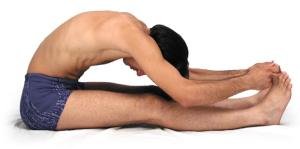What are the obstacles, or antarayas in our yoga practices? What keeps us from moving forward?
Disease is the first obstacle Patanjali mentions. It is a physical impediment and hard to get around. Sometimes there is not much you can do but wait to get better. But, often there are restorative practices that can be helpful
Lack of interest or sluggishness is the second physical obstacle. This is where you can’t quite get yourself to your mat, or to class. There will always be more important things that need doing. The sluggishness can show up as you knowing that you need to get a bolster to sit on for your forward bends, but it is all the way across the room and you don’t feel like getting it. Sitting in a forward bend with your pelvis rotating backwards will certainly keep you from progressing in your pascimottanasana
Doing Pascimottanasana this way is an impediment to progress
Sitting on a height can help the pelvis tip forward.
Lingering doubt, intoxication, pride or carelessness are mental obstacles. You may think that using a belt for Supta padangusthasana is beneath your abilities, but if you cannot keep the legs straight with the leg on the floor remaining in contact with the floor, then you are not cultivating stretch in the hamstrings. Rather you are rounding your spine and potentially causing harm to your low back and hips. At the Iyengar conference, Abhijata talked about the difference between bhoga and yoga. Bhoga is sense gratification only: “Look how high I can raise my leg!” Yoga is the integration of the mind with the body, the breath and the spirit. Raising the leg without distorting the rest of the body.
The leg on the floor pressing into the rolled mat is more important than the height of the lifted leg.
Living in a world of delusion is brantidarshana. I talked about this last week. This is where what we think we are doing is not what we are actually doing. This is an intellectual obstacle.
Lack of perseverance or inability to hold onto progress attained is a spiritual obstacle. When we start yoga as beginners, we go to class and we see great improvements. But then stagnation can slip in if you don’t keep practicing on your own. It is not enough to go to class if you want to keep making progress.
I.30 vyadhi styana samsaya pramada alasya avirati bhrantidarsana alabdhabhumikatva anavasthitatvani cittaviksepah te antarayah
vyadhi - disease
styana - lack of perseverance, lack of interest, sluggishness, mental laziness samsaya doubt, indecision
pramada- intoxication, carelessness, negligence, inattentiveness, inadvertence
alasya - idleness, physical laziness avirati incontinence, lacking in moderation or control, sensual gratification
bhrantidarsana - living under illusion, mistaken notion
alabdhabhumikatva - the point, inability to hold on to what is achieved, disappointment in one’s desired object
anavasthitatvani - an unsettled state, inability to maintain the achieved progress
cittaviksepah - a scattered or oscillating mind causing distraction in the consciousness
te - these
antarayah - obstacles, impediments
These obstacles are disease, inertia, doubt, heedlessness, laziness, indiscipline of the senses, erroneous views, lack of perseverance, and backsliding.
Yoga Sutra I.30 describes the nine obstacles or impediments which obstruct progress and distract the aspirant’s consciousness. These obstacles can be divided into physical, mental, intellectual and spiritual:
These obstacles are:
Physical: disease and lack of interest or sluggishness
Mental: Lingering doubt, pride or carelessness, idleness, sense gratification
Spiritual: lack of perseverance or not being able to hold onto what one has undertaken, the ability to maintain the progress attained due to pride or stagnation in practices.
Iyengar, B. K. S.. Light on the Yoga Sutras of Patanjali (p. 132). HarperCollins Publishers. Kindle Edition.




